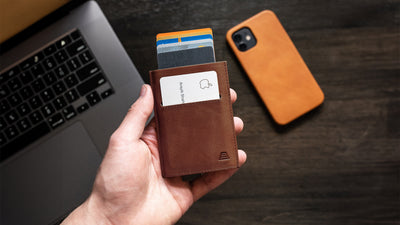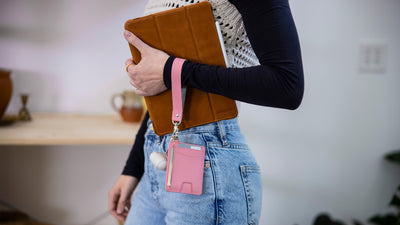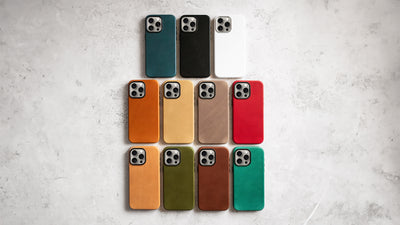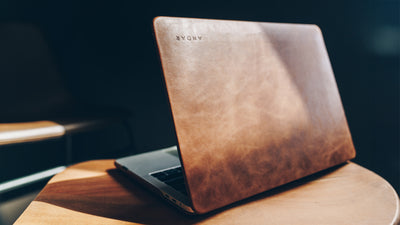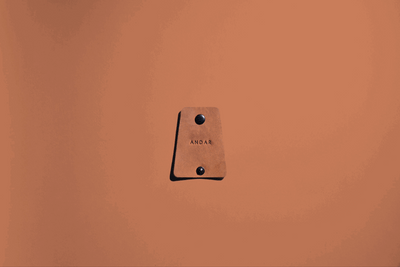The Blog
How To Break in a Wallet
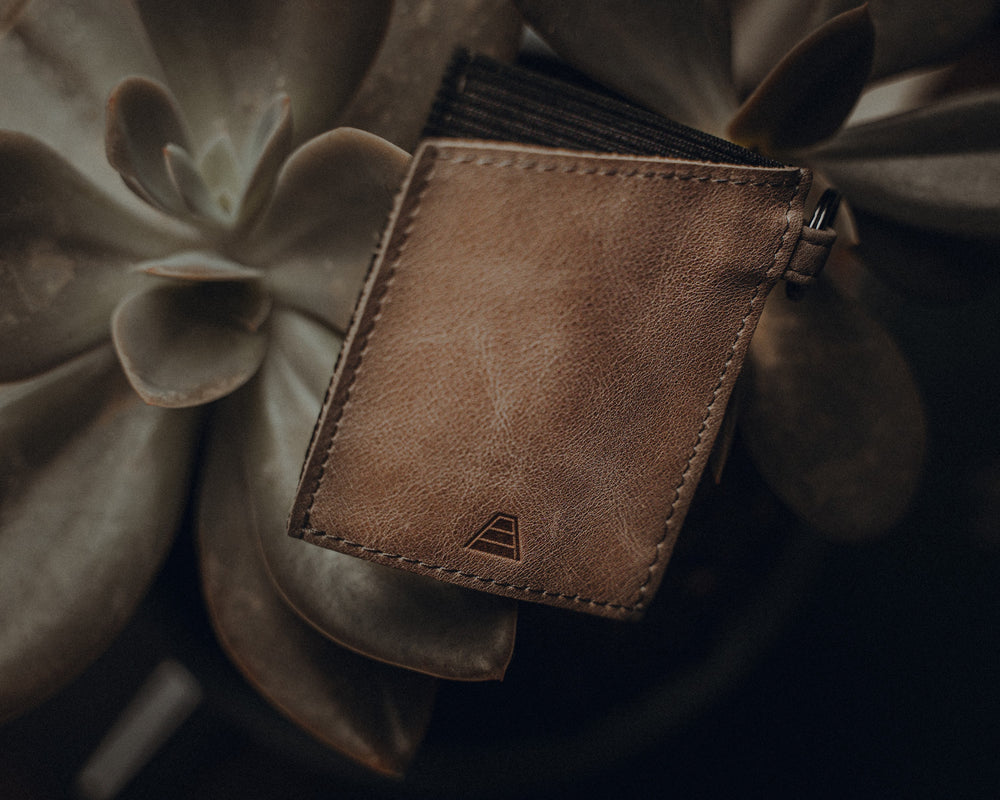
Adults have the distinct pleasure of being able to create the feeling of a Christmas morning almost any day of the week. The excitement that you get from any random or planned purchase is such a rewarding part of the adult experience. However, once you have something new and special, some items need to be broken in so that they can fully shine.
This generally happens a good bit with leather wallets. Especially if you have researched extensively what type of wallet you want, what material you want, or the many other factors that go into your purchase, you will want the wallet to be useful and perfect right out of the starting gate. This is not always the case.
Especially with high-quality full-grain leather wallets, there is a natural stiffness. This is a sign that your wallet is in pristine condition and ready to be shaped to perfectly form to your individual needs.
However, we at Andar know all about leather and leather stiffness. In this article, we’re going to give you a couple of easy ways to get rid of it quickly so you can have the feel of a broken-in wallet as soon as possible.
Follow a few of these steps to really make your wallet feel like it’s been with you since you could remember, even when the box it came in is still in your trash can.
The Reason It Is Stiff
Let’s first start with the reason why a full-grain leather wallet might appear and feel stiff. Because of the arduous (yet rewarding) tanning process, a lot of the chemicals within a finished leather product are actually still in the stages of turning from organic matter to hardened proteins. This means your leather product is technically still in transition.
This Is Not a Bad Thing
Though it is technically still in transition from organic matter to stiff proteins, this is not a bad thing. It is actually best that leather comes out this way for a protective measure while being transported. Instead of taking in the abuse of transportation, it needs your touch to unlock the soft and supple nature of good leather.
Patination (the process of creating a patina) is actually the slow, methodical breakdown of the stiffer chemicals to create a beautiful exterior and change the chemical composition of the leather itself.
What this all means is your leather product needs to be unlocked by your touch to form it into the type of material that you want it to be. Baseball gloves are one of the more tangible examples of this at play. Breaking in gloves is something every athlete is familiar with, and the same holds true for leather wallets.
So How Do I Speed Up This Process?
The process of creating and maintaining leather is backed by years of science. Even when staring the facts in the face, we just want to use our leather right away — it’s kind of like the frustration we have as kids when our new toys don’t come with batteries.
So, you may be asking if there is a way to make this process go faster without damaging the leather. The answer is yes, of course.
Read on below to find a helpful step-by-step process of softening the brand new leather with simple, easy-to-find household items.
Items Needed
In general, these items should be simple to find in order to follow this guide:
- enough plastic credit cards to fill all pockets in the wallet
- olive oil
- water
- lint-free, microfiber cloth(s)
Microfiber cloths are the most important thing to focus on as a regular rag will not work nearly as well. We highly recommend having these cloths around for a variety of leather (and honestly many other) cleaning, maintenance, and general upkeep tasks. They really are one of the most important pieces.
The plastic cards might seem superfluous, but they actually will play an important role in keeping your wallet the correct shape for a more even softening and de-stiffening end product. Even if you will not use that many cards in your day-to-day, for the purposes of this tutorial, the amount really helps with the evenness of softening.
Step 1: Fill Slots with Cards
As explained above, fill all the slots with cards. The cards will begin to stretch out the slots, which will, in turn, stretch out the rest of the wallet. Since it is all connected, if you stretch out the slots, you will stretch out the crease (if it is a sort of bi-fold wallet) and the exterior. Working from the inside out is the simplest way to do this.
For even better results, attempt to put a few cards in each slot progressively. Don’t overdo it, but putting two to three cards in each slot will really make for the best results. If you do this process in rounds, adding a card each round for a few rounds, you will really achieve the elasticity, and broken-in feel that you desire.
Step 2: Time To Use the Olive Oil
Olive oil is the best for this use because it does not have any corrosive elements to it and is generally quite organic. Try to use extra virgin olive oil. Extra virgin olive oil works beautifully and gives a great sheen to our leather (though any olive oil should work fine). If you are open to using it for cooking, it should work nicely on your wallet.
Use your lint-free cloth and begin to dab oil on the wallet. Make sure to get all around the wallet, as even coverage will make for the best results. What the oil does is soaks into the pores of the leather wallet.
The chemicals within the oil begin to break down the harsh leftover chemicals from the tanning process. The soaked pores then begin to widen a little bit, giving elasticity to the overall wallet. Leather and chemical compositions seem to go hand-in-hand.
Step 3: Move It Around
While the olive oil just sitting in the pores helps, a little agitation of the oil and leather together creates a good bit of widening and softening. We suggest opening and closing the wallet several times and taking the cards in and out of slots several times to agitate the oil.
The friction and slight heat that is created by this action will go a long way in softening up your leather. The heat once again opens the pores of the leather more so that you are able to increase elasticity and destroy stiffness altogether.
Step 4: Wipe the Oil Off
Once you have done this for a few minutes and have felt the leather soften a bit, take a different lint-free microfiber cloth and wipe the excess oil off. You don’t want to let it sit on the leather too long. If left to sit and stew, the oils will damage your leather long-term as the oil begins to become rancid and more acidic by being exposed to oxygen.
Keep that process from impacting your leather by simply wiping it down. Make sure to get in all of the little cracks and crannies that are part of the wallet, especially down in the card slots. A cotton swab can be helpful for these tougher areas. Also, pay special attention to the fold if you have a bi-fold wallet.
Never let your wallet dry out in the sun; this sun will make your wallet brittle, cracked, and very, very sad. By changing the chemicals in the leather through this process, your wallet is susceptible to warping or other kinds of damage. Let it dry (indoors, out of sunlight) in the shape you wish to use it in for a few hours before sticking it back in your pocket.
Repetition and Aftercare
With this method, doing it several times might be helpful for extremely stiff wallets. Several rounds can really help break down the chemicals that stiffen your wallet.
In addition, keeping your leather well-conditioned is important for the long haul. This process is very similar to a method of conditioning your wallet. Simply clean your wallet, use a quality Leather Cream, and let it dry. If you can follow this method, the wallet conditioning will be easy for you.
With Stiffness Away, Enjoy Your Wallet Today
When buying new goods, it’s understandable you want to use them right away and show them off. With leather, though, a little care and preparation can create a masterpiece. When you first open up your wallet, the stiffness that you feel will not stay, and you can take a few easy steps to get rid of it quickly!
All you need is a few lint-free cloths, cards, and olive oil to quickly break down the chemicals that cause new leather to be stiff. Of course, you will enjoy the new leather smell a good bit, so maybe the remorse will not be there for you!
Sources:
Chemical composition of tanned leather | Research Gate
